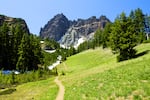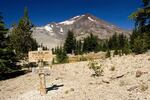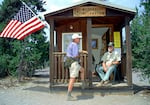
North and Middle Sister are pictured from the summit of South Sister in this Aug. 20, 2013 photo.
Tom Iraci / U.S. Forest Service
The first time Jessica Beauchemin hiked South Sister, she saw two guys leaving as she pulled into the trailhead parking lot.
“You don’t want to go up there today,” she recalled them saying. “It’s gonna snow.”
This was in 2006. It was October — very late in the season to try to summit the 10,358-foot mountain in the Central Oregon Cascades — but Beauchemin was determined to ascend a glaciated peak in order to qualify for membership in the Mazamas mountaineering group.
“And I said, ‘OK, thank you,’” said Beauchemin, a personal trainer who lives in Bend. “In the back of my mind, [I was] thinking if the weather turns I’ll just turn around and go home. There’s no reason to push it.”
To her memory, she didn’t encounter a single other person throughout the 12-mile hike. At the top, tiny snow flurries swirled around her like in a snowglobe.
“To be at 10,000 feet by myself in that magical snow flurry was one of the pinnacles of my hiking experiences in Oregon,” Beauchemin said.

Hikers ascend South Sister in Central Oregon, Sunday, Oct. 18, 2020.
Bradley W. Parks / OPB
A crowdless hike up South Sister these days is rare, even in October. A weekend visit to the climber’s trail, which starts at the Devils Lake trailhead, usually features cars parked shoulder-to-shoulder and bumper-to-bumper around the circular parking lot. Groups of hikers and trail runners have to squeeze past each other in some spots.
The crush on popular trails like South Sister in Central Oregon reached a tipping point a few years back. Damage associated with overcrowding had gotten so bad that the U.S. Forest Service decided — and many recreationists agreed — an intervention was needed.
“The amount of use that was occurring was off the charts,” said Jean Nelson-Dean, public affairs officer for the Deschutes National Forest. “And so, fundamentally, if folks are going to have a wilderness experience, there still needs to be a wilderness to experience.”
Related: Permit program to reduce crowds on popular Oregon trails back on after pandemic delay
Starting this weekend, the agency is limiting the number of day-users at 19 of the most popular trailheads across the Three Sisters, Mount Jefferson and Mount Washington wilderness areas. The plan also limits the number of overnight stays across routes from all 79 trailheads in those wildernesses.
That means hikers and campers will likely see fewer people on the trail this summer than have become the norm. The South Sister climber’s trail will only permit 100 hikers a day now, not counting overnight campers.
While that may delight many a seasoned solitude-seeker, others worry that requiring permits could deter people out of wilderness exploration in the first place.
“I feel very strongly that there is currently a divide as to who has access to the outdoors,” Beauchemin said. “And this is only going to serve to really entrench that divide.”
Beauty is a beast
Part of what draws people to Central Oregon is how easy it can be to get from the driveway, car-camping site or hotel parking lot to wilderness areas that feel very remote.
“And with social media, people have really gravitated toward places that are either the most beautiful or the most accessible,” said Matt Reeder, who teaches French at Portland Community College and has authored several guide books for hiking in Oregon.
“The places that are both have become particularly very, very, very popular.”

No Name Lake at the summit of Broken Top is pictured in this 2015 photo.
U.S. Forest Service
Climbing South Sister, for example, or trekking to the mesmerizing No Name Lake on Broken Top are both physically taxing hikes but well within reach for many people. Several hikers who spoke with OPB related moments of serenity in the Central Cascades that had profound impacts on their lives.
Shanna Anderson is an office manager in Springfield. She hiked a little when she was growing up, but didn’t initially pursue it as an adult.
“I saw these ultra-athletes and these really macho people out in the wilderness — these people that lived that lifestyle — and I just didn’t connect with them,” Anderson said. “It just didn’t seem real for me.”
Anderson later found inspiration from popular Oregon hiking groups on Facebook like Hike Oregon. The page moderators posted about outdoor adventures in a way that felt accessible for her.
After building some courage on day hikes, she and her husband planned a 24-mile loop hike around Three-Fingered Jack with “five-dollar backpacks from the ’70s.”
“It was grueling. It was hard, but I just loved every second of it,” Anderson said. “To this day, that’s probably one of my favorite backpacking trips I’ve ever been on. I was just like, ‘Wow, I’m doing it. I’m out here. I’m roughing it.’”

The trail to Upper Canyon Creek Meadow near Three-Fingered Jack is pictured in this July 24, 2017 photo.
Bonnie Moreland
And it’s partly the job of public land agencies to encourage those experiences. However, the recreation boom in Central Oregon has been too much for many of these fragile natural areas to handle, according to the Forest Service.
The Wilderness Act of 1964 requires land managers to preserve wilderness areas and the qualities that make them wild and to promote public access. Trying to strike a balance between those two priorities presents a complex set of challenges, especially given the seemingly boundless uptick in visitors.
Nelson-Dean said visits to the Deschutes National Forest have jumped from 1.8 million in 2013 to 4.5 million last year — that’s comparable to peak visitation at Rocky Mountain National Park.
“I don’t know what else they can do besides implement a permit system,” Reeder said. “I just don’t know what the alternatives are. And if the alternatives existed, I’m not sure if they’re even manageable or even feasible.”
Raising the bar
Permits and quotas for hiking and camping are nothing new. In fact, two trails now covered by the Central Cascades Wilderness Permit system — Pamelia Lake and Obsidian — have had a limited entry since the 1990s.
What makes this new system unique is the scale. It covers some 450,000 acres, making it one of the largest wilderness conservation efforts by way of crowd control in the nation, the Statesman Journal reported in 2019.
“If people have never been exposed to these areas in the first place, now [the permit] almost acts as a barrier to potentially getting out there,” said Zavi Borja, programs coordinator for Vámanos Outside, a group seeking to connect Latinx families to the Central Oregon outdoors.
That’s on top of existing barriers to the wilderness like discrimination, transportation, physical ability, local knowledge and outdoor education.
Related: Racism in the great outdoors: Oregon's natural spaces feel off limits to Black people
Permits are available online at Recreation.gov, over the phone, or at Forest Service offices on the Willamette and Deschutes national forests. The Forest Service is also making a small number of permits available at local libraries.
But securing a permit is still tough, even for those well-versed in public lands bureaucracy.
“I have a lot of positionalities myself,” said Borja, who grew up in Madras and now lives in Bend. “I was born here. I went through the education system. I have a degree, right? But [the system is] tough, man, it’s not easy.”
Borja added that Latinx families, in particular, may be wary of handing over personal information to a federal agency just to take a hike.
The wilderness hype machine
The Forest Service released a select number of permits for the full season — which runs from Memorial Day weekend through the end of September — at 7 a.m. on a Tuesday in early April.
“It was an organizational challenge between myself and several friends,” said Anderson, from Springfield. “We all chatted for months ahead of time and kind of jokingly said we need an Excel spreadsheet.”
The agency said that the initial dump was intended for planning types who wanted to lock in spots on some of the most popular trails, but it quickly turned into Black Friday.
Nelson-Dean said about half the traffic that day on Recreation.gov — which allows people to book reservations at more than 100,000 trails, campsites and cabins nationwide — was for Central Cascades Wilderness Permits.
“A lot of the most popular ones were gone in about 30 minutes,” Nelson-Dean said. “What followed was a little bit of panic, people just kind of grabbing whatever they could get and not really thinking about what roads would be open, weather conditions and those kinds of things.”

A sign marks the entrance to the Green Lakes Area at the base of South Sister in this 2015 photo.
U.S. Forest Service
It’s the same force that drives streetwear aficionados to wait hours in line or online to buy nail clippers stamped with the Supreme logo. People like to have things not a lot of other people have, whether they’re worth it or not.
For example, people gobbled up available permits for Green Lakes west of Bend, even in late May and early June when it’s still blanketed with snow.
Nelson-Dean said people likely bought permits because they thought they couldn’t get one later when, in fact, the Forest Service makes new permits available daily. That’s for all 19 trails in the system, including 80 new Green Lakes permits every morning.
“We haven’t tried to make these exclusive by any means,” Nelson-Dean said.
The agency stepped in to inform people what they were actually buying and, in some cases, canceled reservations.
Anderson said she fears people will treat permits like tickets to an event and go regardless of conditions at the trails themselves.
Waiting and seeing
The Forest Service’s stated intention is to spread use out over time and space, encouraging people to explore more trails in the three wilderness areas and go on more weekdays if they can.
Despite public announcements, fliers at trailheads, news articles and a several-year buildup, there will undoubtedly be people who show up at popular spots permit-less and looking to hike.
“I hope that it spurs people if they can’t get a permit for a place, to not get angry and then be mad and try to go hike a place anyway,” said Reeder, from Portland. “There are plenty of phenomenally beautiful hikes in this region that don’t require a permit for a day hike.”
Trail volunteers and wilderness rangers will be out and about trying to help people navigate the new permit system. There is a $200-plus fine for violations, but Nelson-Dean said the agency will focus on education and engagement over enforcement in this first year.
“Our goal is to get people to understand the permit system, to do the right thing, to still enjoy wilderness,” Nelson-Dean said. “When we started this, the goal was to provide as much wilderness access as possible to people today while still maintaining access for those future generations.”

A wilderness ranger sits at the Green Lakes Trailhead in this 2015 file photo.
John Hutmacher / U.S. Forest Service
Many hikers have voiced frustration that fees attached to the permits will not go toward enforcing parking, littering or other rules. The $1 day-use and $6 overnight fees will pay solely for the Recreation.gov service.
One thing that is clear, though, is that limiting crowds will not lessen demand. In fact, it may only fuel it. Just ask anyone who’s hiked in the access-limited Enchantments in Washington’s Alpine Lakes Wilderness Area west of Leavenworth. Or anyone who scored some Supreme nail clippers.
Beauchemin, from Bend, has climbed South Sister several times since that first solo experience in 2006. She stopped going in recent years because it’s gotten too busy.
“I can leave it to the people who haven’t done it yet,” Beauchemin said. “It’s definitely one of the iconic places to see in Oregon. I think everybody who lives here and visits here should go at least check out some of it, even if you don’t summit.”
Beauchemin said she agrees with the Forest Service’s goal to preserve places like the South Sister climber’s trail, but she doesn’t think a permit system is the way to get there. She’d rather see more investment into mentorship for new hikers and campers, or even just parking enforcement.
“I don’t think people should be scared away from going outside,” Beauchemin said. “They’re going to keep coming — with a permit or not.”


